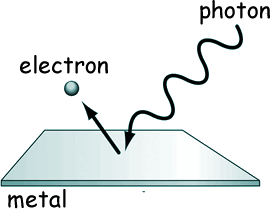What is the wavelength of light that hits potassium metal in order to eject photoelectrons with a wavelength of #"0.57 nm"#? The ionization energy of potassium is #"4.34 eV"#.
1 Answer
I got ultraviolet light of about
We first consider the photoelectric effect.

As we are bombarding a metal surface to eject an electron, it has leftover kinetic energy
#K_e = hnu - hnu_0 = hnu - hnu_0# where
#h# is Planck's constant.
Recall that for every wavelength
#K_e = (hc)/(lambda) - hnu_0#
Since the photoelectrons are to have the wavelength of
#lambda = h/(mv) = h/p# where
#m# ,#v# , and#p# are mass, speed, and momentum, respectively.
Recall that for mass-ive particles,
#K_e = (h//lambda)^2/(2m)#
#= (6.626 xx 10^(-34) "kg"cdot"m"^2cdot"s"^(-1) // 0.57 xx 10^(-9) "m")^2/(2 xx 9.109 xx 10^(-31) "kg")#
#= 7.417 xx 10^(-19) "J"# ,
or
#overbrace("4.63 eV")^(K_e) = (hc)/lambda - overbrace("4.34 eV")^(hnu_0)#
or
#overbrace(7.417 xx 10^(-19) "J")^(K_e) = (hc)/lambda - overbrace(6.952 xx 10^(-19) "J")^(hnu_0)#
Thus,
#color(blue)(lambda) = (hc)/((7.417 + 6.952) xx 10^(-19) "J")#
#= (6.626 xx 10^(-34) "J"cdot"s" cdot 2.998 xx 10^(8) "m/s")/(1.437 xx 10^(-18) "J")#
#= 1.382 xx 10^(-7) "m"#
#=# #color(blue)("138.24 nm")#

